Cilium
![]()
This article discusses the cell processes in the animal and plant kingdoms. The cilia on the eyes of mammals are discussed in the article cilium.
The cilium (Latin cilium 'eyelash') is a special form of the cell process in cells of eukaryotic organisms. The cylindrical, 5-10 µm long and about 250 nm slender protrusion of the cell membrane contains, in addition to cytoplasm, a tubular skeleton of bundles of microtubules, the so-called axoneme. This skeleton consists of nine microtubule doublets (9×2) arranged in a circle, in the middle of which there may be two central microtubules (9×2+2) or not (9×2+0). A distinction is then made between
- Secondary cilia with central microtubules, blueprint 9×2+2, most of which are actively motile, motile.
These are also called kinocilia, cilia or cilia and are grouped together with the similarly constructed, somewhat longer flagella of eukaryotes as undulipodia ("wave-beating feet"). While individual cells move themselves by movements of their flagella, epithelial cells that are connected to each other use their cilia to move fluids in the bronchi or an egg in the fallopian tube across the epithelial surface in a coordinated action.
- The intrinsic mobility of secondary cilia is only possible if they are equipped with additional proteins that connect the microtubule pairs to each other (nexin band, radial spokes) and displace them in relation to each other (dynein arms). If these are missing, even cilia with a 9×2+2 pattern are not motile, such as the olfactory receptor-bearing cilia of olfactory cells.
- Primary cilia lacking central microtubules, 9×2+0 blueprint, usually only passively motile.
It is possible that all cells of the human body carry such a primary cilia, which plays an important role during embryonic development and in the differentiation of tissues and can serve as a mechanosensor or chemosensor.
- However, a (primary) structure without centrally located microtubules does not in principle exclude active motility. The nodal cilia - named after the embryonic primitive node (Latin nodus 'node'), a formation during the gastrula phase of mammalian embryonic development where this type of cilia was discovered - for example, are 9×2+0 built and yet motile. Their activity generates an asymmetric periembryonic flow that leads to the lateral-different expression of signaling proteins (such as Nodal) and, via them, the lateralization of internal organs.
For a long time, research interest was focused almost exclusively on the kinocilia, which are conspicuous by their mobility, while the inconspicuous primary cilia were seen but paid little attention to. However, since it became apparent around 2000 that the development of the animal organism and the function of many of its organs depend crucially on the presence of healthy primary cilia, these have been intensively studied, as have the diseases associated with them as ciliopathies, such as Kartagener's syndrome in humans.
Cilia are found in many eukaryotes. In animals, they are found on almost all cell types, but are rare in plants, especially not in flowering plants, but present, for example, in palm ferns. In nematodes and arthropods, only primary cilia are found in some neurons. Unicellular organisms such as ciliates possess only secondary kinocilia.
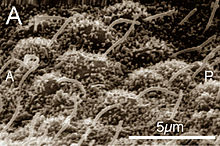
Primary cilia are also the nodal cilia of a mouse embryo (electron micrograph)
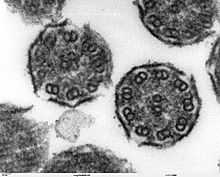
Secondary cilia under the electron microscope: in cross-section the structure 9 × 2 + 2 becomes visible.
Secondary cilia
Structure and occurrence
Each cilia is surrounded on the outside by a plasma membrane. Inside the cytoplasm, as a special formation of the cytoskeleton, lies the so-called axoneme consisting of bundles of fine hollow tubulin fibers, the microtubules. In secondary cilia, these are arranged according to the 9×2+2 pattern: In the middle of the cilium, two single central tubules (singletons) lie in a sheath-like envelope (central sheath). These two central singlet tubules are surrounded in a circle by nine double tubules (doublets), each consisting of an A tubule and a B tubule fused to it.
At each A-tubule there are pairs of arm-like structures (dynein arms), which are directed towards the B-tubule of the neighbouring doublet. The dublets arranged in a circle are connected to each other in a ring by nexin binding members as well as to the enveloped central tubules by so-called radial spokes.
All twenty microtubules originate from a basal corpuscle, the formation center of the cilia at the base of the cilia. Fibers of the transition zone anchor this kinetosome in the cell membrane and separate the membrane-enveloped cilia with the axoneme from the rest of the cell body in such a way that one can speak of compartmentalization.
The beat of a secondary cilia as an active movement is produced by energy-requiring tensions of the microtubules inside the cilia. The movement process can be described as a sliding filament mechanism. Arms of dynein, always anchored to the A-tubule, make contact with the B-tubule of the next neighbouring tubule with their tips and can cause an ATP-dependent displacement of the doublets towards each other, so that a bending is produced. Nexin, a highly extensible protein, holds adjacent doublets together during this sliding process.
Such kinocilia are often formed in large numbers on the cell surface of unicellular or multicellular organisms. Flagella and cilia are also scientifically summarized under the generic term undulipodia (singular undulipodium), due to the same construction principle.
Some ciliates possess groups of cilia that are interconnected. Such groupings of projections are also called cirrus (Latin for curl).
Occasionally, cilia are not distinguished clearly enough from microvilli. These, however, do not carry a scaffold of microtubules, but are equipped with actin filaments, furthermore of a different origin and usually only passively mobile. Microvilli, not cilia, are found for example in the intestines of mammals, where they serve to increase the surface area. Here, the food pulp is moved by the peristalsis of muscle cells. Another example of cell processes that are wrongly called cilia are the formations of hair cells in the inner ear. The stimulus-receiving processes of these sensory cells, formerly called stereocilia, are also microvilli and are therefore now called stereovilli. A cilium exists in the human hair cell only in the embryonic anlage and degenerates during development.
The cilia should not be confused with the flagella of bacteria. These are much slimmer, consist entirely of protein (flagellin) and are not surrounded by a membrane. Their mode of operation is also based on a completely different principle (namely a rotation similar to a ship's propeller).
Movement and function
Kinoceils are rarely found alone, but usually in larger numbers and often in rows or fields on a cell. The coordinated, oar-like beating of the motile cilia serves the following functions:
- Locomotion of the individual cell, as in ciliates, numerous larval stages of smaller, water-dwelling animals or also the sperm of higher animals.
- swirling of particles of food
- Transport of particles and fluids within an organism, for example through the ciliated epithelium in the airways a transport of mucus and foreign substances from the bronchi or through ciliary epithelial cells in the fallopian tube the transport of an ovum.
Cinematic cilia are, so to speak, flexible miniature rudders which, in contrast to flagella, beat uniplanarly (in one plane). The plane and direction of stroke are fixed for each cilia. During the powerful stroke the cilium is almost stretched. The slower recoil is curved, with a bending wave running from the base of the cilia to the tip of the cilia, returning the cilium to its original position when there is little resistance from the surrounding medium. A curve in space can be traversed at the same time.
Each cilia of a cilia row beats a fraction later than the previous one. This is called a metachronous movement. The collective movement is wave-like, comparable to a field of grain swaying in the wind.
The beat frequency of a cilium can be between 5 and 20 Hz, depending on environmental conditions. There are factors that can accelerate the frequency, such as heat or some medications. Other factors, however, inhibit the frequency or even cause it to stop, such as nicotine or a bacterial infection.
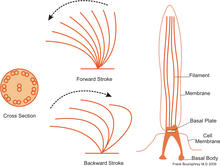
The powerful stroke forward is followed by a slower curved backward motion of the cilia
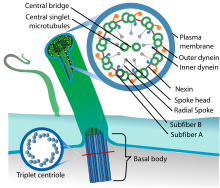
Scheme of a secondary cilie

Cilia of the bronchiolar epithelium, besides some microvilli are visible (lower right in the picture)
Primary cilia
In contrast to the mostly actively movable, "motile" secondary cilia, primary cilia are mostly only passively movable. As a rule, only one such "non-motile" cilia exists per cell, which is formed according to the 9×2+0 scheme - the central pair is thus missing.
Almost all vertebrate cells possess a single nonmotile cilium, also called the "primary cilium", which has long been neglected in research. These primary cilia often represent a sensitive extension of the cell. Specialized structures have also evolved from these nonmotile cilia; for example, the outer segment of photoreceptor cells in the eye is connected to the inner segment by a specialized cilium called the connecting cilium.
In contrast, olfactory cells, as sensory cells of smell in vertebrates at the same time olfactory nerve cells, each have up to twenty nonmotile cilia with special olfactory receptors; however, these special nerve cell processes are structured according to the 9×2+2 scheme of secondary cilia.
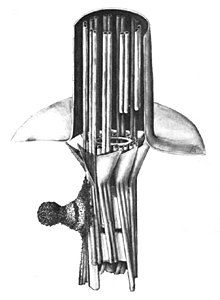
Representation of the basal apparatus of a cilium with the kinetosome
Questions and Answers
Q: What is a cilium?
A: A cilium is an organelle found in eukaryotic cells.
Q: What are the two types of cilia?
A: The two types of cilia are motile cilia and non-motile, or primary cilia.
Q: What is the function of motile cilia?
A: Motile cilia beat against fluid outside the cell and are found on protist ciliates like Paramecium. They are how Paramecium moves around. They are also found on the epithelial cells of many internal organs of metazoans, such as the digestive system and the trachea of the lungs.
Q: What is the function of non-motile, or primary cilia?
A: Non-motile, or primary cilia, typically serve as sensory organelles.
Q: What is undulipodia?
A: Undulipodia is a group of organelles that includes cilia and flagella.
Q: Are eukaryotic cilia and flagella structurally identical?
A: Yes, eukaryotic cilia are structurally identical to eukaryotic flagella, although distinctions are sometimes made according to function and/or length.
Q: Where are motile cilia found?
A: Motile cilia are found on protist ciliates like Paramecium, as well as on the epithelial cells of many internal organs of metazoans, such as the digestive system and the trachea of the lungs.
Search within the encyclopedia